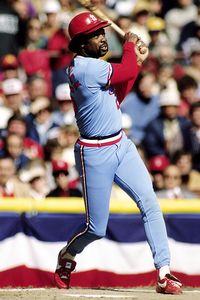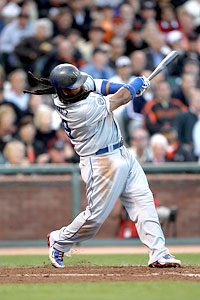Baseball uniforms have changed surprisingly little over the past century. Sure, fabrics have gotten lighter, color schemes are a bit bolder and cap brims are a little longer. But when you look at the big picture, only one uni element has undergone a major change: the pants. Yes, a handful of players still wear their pants high, but they're few and far between.

Judging by the constant stream of e-mail Uni Watch receives, lots of fans don't care for the pajama-pants look favored by so many of today's players. Uni Watch doesn't like it either, but there's nothing we can do about it, because MLB doesn't have a rule regarding pant length. If the commissioner's office tried to impose one, that would constitute a change of the game's rules, which would require the approval of the players' union (an approval you can be sure it'd never give). And even if such a rule somehow got through, players would probably just violate it and accept whatever fines were levied, just like football players do when they don't feel like following the NFL's uni guidelines.
In other words, the pajama look isn't going anywhere, at least for now. So instead of complaining about it, let's try to understand it. How and why did pants go from the kneecap to the shoetop? And why is there such a disconnect between what fans prefer to see and what players prefer to wear?
Piecing together the exact combination of events and influences that led baseball cuffs to head south is probably impossible -- there are too many intangibles, too many small but telling moments that were never properly documented. But after some intensive research and a lot of deep thought, Uni Watch has identified the following factors that have contributed to the transition from high cuffs to low:
1. George Hendrick. Wondering if one person deserves the credit (or blame) for today's low-cuffery? Look no further than Hendrick. When he came up with the A's in the early 1970s, he wore his pants pretty much like everyone else, at mid-shin (that's him with his back to the camera). A decade later, however, he began wearing his pants down to his ankles -- a startlingly low cuff level for that era. A few other players soon followed (including Ron Darling, who referred to the long pants as his "no-nonsense look"), laying the groundwork for the low-cuff revolution that eventually materialized.

Hendrick kept his pants low for the rest of his career and still wears them low today while coaching first base for the Rays. Uni Watch had hoped to pick his brain and get the full story behind his trend-setting shin stylings, but Hendrick is famously media-shy and declined to be interviewed -- too bad. (Ironically, the Rays have recently been engaging in some old-fashioned high-cuffery, but Hendrick has refused to play along.)
2. The Clemson cut. While Hendrick is probably the most influential figure in the history of big league britches, he was actually beaten to the low-cuff punch by a college team: the 1978 Clemson University squad. Of course, college baseball was practically invisible back then, so hardly anyone noticed when Clemson coach Bill Wilhelm decreed that his players would wear long pants. Over the years, though, the low-cuff look has become Clemson's signature style (some sporting goods outlets even refer to the Tigers' long pants as the "Clemson cut") and was undoubtedly one of the earliest influences to give legitimacy to the pajama look.
3. The sock factor. Baseball pants compete for lower-leg real estate with baseball socks. Socks easily won that battle around 1900, when ballplayers showed their colors by wearing knickers and colored stockings (that's how we got team names like the Red Sox and White Sox). But thanks to the introduction of stirrups around 1910, the story of baseball hosiery over the course of the 20th century was basically a story of less and less color and more and more white. What's the point of exposing your colored hosiery if the color is reduced to a pencil-thin strip?
Stirrups became officially irrelevant in 1991, when Twins pitcher Scott Erickson stopped wearing them altogether and instead wore solid black socks. Or at least that's what it looked like -- turns out he was actually wearing his stirrups really low to look like solid socks (more details on that here). In any event, the visual message being delivered was the same: If you didn't want to wear stirrups, you didn't have to, even if they were part of your team's official uniform.
By allowing so much variety on the hosiery front and failing to enforce any kind of sock standards, MLB was essentially saying, "Socks, eh, they don't matter." And if they don't matter, why bother showing them? Why bother cuffing your pants just so and painstakingly readjusting them each time you slide? Why not just cover up your socks with long pants? And that's exactly what most players decided to do in the 1990s.
And as long as we're talking about socks, let's also discuss ...
4. The footwear factor. High cuffs look great with low-top baseball cleats. But as players began switching to mid- and high-top cleats in the late 1980s, hiked-up pants suddenly didn't look so good. It's just a dorky look, and players wearing this kind of cleat quickly figured out they were better off pulling their pants all the way down. Even better (or worse, depending on your point of view), the high-top footwear offered players a new style option: They could tuck their pants directly into their cleats.
Of course, there are other ways to keep your pants low besides jamming them into your shoes. Which leads us to ...
5. The MacGyver factor. Why wear your pants low when you can wear them really low? That's the challenge many MLBers began to embrace beginning around 1999, as players began competing in the "How low can you go?" sweepstakes by making alterations to their pant legs. The simplest adjustment was to cut out the elastic bands at the bottom of the cuffs, allowing the pants to droop all the way down without riding back up. Barry Bonds went further, wearing little elastic straps that kept his cuffs tethered to his cleats (the pajama look on steroids, so to speak), a style that quickly caught on with several of his teammates. Then there were the players who cut slits in their pant cuffs and used their shoelaces to tie their pant legs to their shoetops. Others used Velcro to keep their cuffs stuck to their cleats. And still others sttrrrrreeetched their cuffs under their heels and impaled them on their spikes.
MLB eventually banned all these maneuvers, but enforcement has been lax and players are too wealthy to care about the fines. Case in point: Pedro Martinez was fined $5,000 for doing the heel-spike thing in 2006, but that didn't keep him from doing it again just last year. And that provides a convenient segue to the next item on our list ...
6. The Dominican factor. Uni Watch reader Michael Niekamp recently checked in with the following dispatch:
Four years ago I began playing in a competitive fastpitch softball league made up of players who were born in the Dominican Republic. Most of the guys wear their pants in what they call "the Dominican style," which is baggy and long with the backs of the pants hooked under the cleats to keep them in place. Many of the guys played in the low minors and say the Dominicans invented and developed this style while playing in their native county and brought it with them to the States after they were drafted.
It appears to be true. I have been lucky enough to go to the Dominican three times to play in tournaments and almost all the guys we have played against over there have worn their pants in the Dominican style.
Further Uni Watch research has confirmed that the Dominicans are generally credited with the heel-spike concept. And when they can't get away with stretching their cuffs under their heels, they still like their pants really long and baggy. So count this as an underacknowledged consequence of the growing Dominican presence on the diamond.
7. "You can't make me!" If you want to see players wearing their cuffs up high, they're not hard to find. First, watch some high school or college games, because many of the coaches are old-schoolers who require their players to go high-cufffed. Then check out some minor league action, because many MLB teams require high cuffs throughout their minor league systems.

All of which makes today's young players associate the high-cuffed style with crotchety old fuddy-duddies who told them how to dress a certain way. Once they make it to the majors, they want to leave that style behind, just like they stop wearing double-earflapped batting helmets. And if a player doesn't feel that way himself, he'll often face peer pressure from teammates. Check out this quote from David Wright's blog in 2006 (yes, Wright had a blog): "The veterans on the team give me a hard time about it when I wear the pants up. ... I guess the general feeling is that the pants-up look is a high school or college type of style. Not that there's anything wrong with that, but there's a high value on looking and acting like a professional in this clubhouse."
Of course, "looking like a professional" is in the eye of the beholder, but you get the larger point. (As an aside, Wright now has one of the strangest pants protocols in the bigs: Since 2008, he's gone high-cuffed for day games and low-cuffed for night games, an odd system that he's never explained except to say, "That's just how I like to do it.")
8. What happens off the diamond can influence what's on the diamond. Have you looked at the way people are wearing their jeans these days? Long and baggy -- not unlike what a lot of ballplayers are now wearing. That's surely no coincidence.
OK, so that's a rough look at how big league pants got long. But even after all that, pajama pants look so godawfully bad on the field. They make a player look so slow and awkward, so dumpy. And don't long pants just make a hot day feel even hotter? Why would a player choose to dress this way?
That's a tricky question because the low-cuffer's deviant thought processes are completely alien to Uni Watch. This made it necessary to go straight to the horse's pants, so to speak: Over on the Uni Watch Blog, readers who'd gone low-cuffed on the diamond were recently asked to explain why. Several dozen of their responses have been compiled for your consideration here. If that's too much to read, the average comment went something like this: "Wearing my pants long is way more comfortable. Plus it offers more protection when sliding. And it's how the big leaguers wear their pants, so that's how I want to wear mine."
Sigh. But there's a glimmer of hope that inseams could once again grow shorter -- a glimmer rooted in earliest baseball uniforms of the late 1840s. Back then, uniforms routinely featured long trousers but players often tripped over their pants, so teams experimented with belted or buttoned leg openings to keep the fabric from getting in the way. It wasn't until 1868 that the Cincinnati Red Stockings became the first team to go with knickers instead of trousers. And as it happens, players are tripping over their long pants nowadays, too (it's also happened to Josh Hamilton this season). Could that lead the pendulum to swing back toward shorter pants?
Uni Watch sincerely hopes so. We don't have to go overboard, mind you. But somewhere between that look and today's look, there has to be a happy medium.
Paul Lukas has always gone high-cuffed while playing softball. If you liked this column, you'll probably like his Uni Watch Blog, plus you can follow him on Twitter and Facebook. Want to learn about his Uni Watch Membership Program, be added to his mailing list so you'll always know when a new column has been posted, or just ask him a question? Contact him here.
 |
| • Philbrick: Page 2's Greatest Hits, 2000-2012 |
| • Caple: Fond memories of a road warrior |
| • Snibbe: An illustrated history of Page 2 |
| Philbrick, Gallo: Farewell podcast |
- Sports journalism's foremost uniform reporter
- ESPN.com columnist since 2004
- Also blogs at uni-watch.com
ALSO SEE
- Uni Watch: World Cup preview, Part 4
- Uni Watch: World Cup preview, Part 3
- Uni Watch: World Cup uni grades
- Uni Watch: World Cup uni grades
- Lukas: A storied century of history at Everlast
- Lukas: Uni Watch on spacey Astros' innovations
- Lukas: Uni Watch's 2010 MLB preview
- Lukas: Uni Watch welcomes spring training
ESPN TOP HEADLINES
RECENT ACTIVITY
-
TOOLS
- Contact Us
- Corrections
- Daily Line
- RSS
